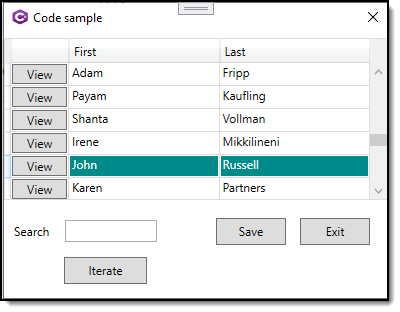Hello @DPlug
Note that the following are not plug in code solution but instead paths to lead you to what you want.
Following along with the following Microsoft code sample. Then for a start see the following TechNet article and code which does not have a ComboBox nor DataGrid but instead a ListBox, don't get hung up on the ListBox.
The screenshot below is for the TechNet article, ignore VB.NET as the actual code has one project for C#, one for VB.NET

DataGrid

MainWindow Modified source
protected override async void OnContentRendered(EventArgs e)
{
base.OnContentRendered(e);
if (_hasShown)
{
return;
}
_hasShown = true;
var employeeCollection = new ObservableCollection<Employees>();
//await Task.Run(async () =>
//{
// employeeCollection = new ObservableCollection<Employees>(await _context.Employees.ToListAsync());
//});
await Task.Delay(1);
employeeCollection = new ObservableCollection<Employees>(EmployeesOperations.List());
EmployeeGrid.ItemsSource = employeeCollection;
employeeCollection.CollectionChanged += EmployeeCollection_CollectionChanged;
DataContext = employeeCollection;
/*
* Find employee by last name, if found
* select and scroll into view in the DataGrid
*/
var employee = (employeeCollection)
.FirstOrDefault(emp => emp.LastName == "Russell");
if (employee == null) return;
EmployeeGrid.SelectedItem = employee;
EmployeeGrid.ScrollIntoView(employee);
SaveButton.IsEnabled = true;
}
Data reader
Code added, used above. Note extension class DbExtensions should be in it's own file
using System;
using System.Collections.Generic;
using System.Data;
using System.Globalization;
using System.Linq;
using System.Text;
using System.Threading.Tasks;
using Microsoft.Data.SqlClient;
using WpfApp1.Models;
namespace WpfApp1.Classes
{
public class EmployeesOperations
{
public static string ConnectionString =
"Data Source=.\\SQLEXPRESS;database=HumanResources;Integrated Security=True";
public static List<Employees> List()
{
var list = new List<Employees>() ;
var selectStatement =
@"
SELECT
employee_id, first_name, last_name, email, phone_number, hire_date, job_id, salary, manager_id, department_id
FROM
dbo.employees;
";
using (var cn = new SqlConnection() { ConnectionString = ConnectionString })
{
using (var cmd = new SqlCommand() { Connection = cn, CommandText = selectStatement})
{
cn.Open();
var reader = cmd.ExecuteReader();
while (reader.Read())
{
var employee = new Employees()
{
EmployeeId = reader.GetInt32(0),
FirstName = reader.GetString(1),
LastName = reader.GetString(2),
Email = reader.GetString(3),
PhoneNumber = reader.SafeGetString(4),
HireDate = reader.GetDateTime(5),
JobId = reader.GetInt32(6),
Salary = reader.GetDecimal(7),
ManagerId = reader["manager_id"].DbCast<int>(),
DepartmentId = reader.GetInt32(9),
Manager = new Employees(),
InverseManager = new List<Employees>()
};
list.Add(employee);
}
}
}
return list;
}
}
public static class DbExtensions
{
public static T? DbCast<T>(this object dbValue) where T : struct
{
switch (dbValue)
{
case null:
case DBNull _:
return null;
}
T? value = dbValue as T?;
if (value != null)
{
return value;
}
if (dbValue is IConvertible conv)
{
value = (T)conv.ToType(typeof(T), CultureInfo.InvariantCulture);
}
return value;
}
public static string SafeGetString(this SqlDataReader reader, int colIndex)
{
if (!reader.IsDBNull(colIndex))
{
return reader.GetString(colIndex);
}
return string.Empty;
}
}
}





